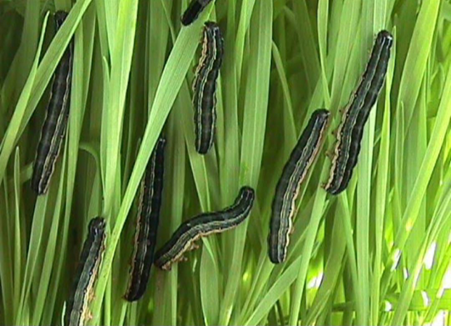
Grain SA is aware of the recent African armyworm outbreaks that started in Bronkhorstspruit in Gauteng, and Carolina and Badplaas in Mpumalanga and that have spread to the North West and Limpopo provinces.
African armyworm (Spodoptera exempta) is a sporadic migratory pest that occasionally invades South Africa from central African countries.
It typically arrives during January to April when wind patterns carry the flying moths into the region. Outbreaks have been currently flagged in Zimbabwe and Malawi. While the African armyworm can cause significant damage to veld grasslands, kikuyu lawns, and maize crops, it is important to note that these insects do not typically breed in South Africa due to the colder climate, and that their populations die off before winter.
Maize producers in the Mpumalanga and Gauteng regions, whose crops are beyond the tasselling stage, should not be overly concerned as the armyworm prefers younger, fresher maize plants provided the pasture food source is depleted. However, should the armyworm migrate to younger maize crops in other provinces, this could pose a larger threat. The larvae of the armyworm consume entire leaves, leaving only the veins, and can damage maize silks and ear tips if present.

Livestock producers are encouraged to monitor their pasturelands closely to determine sudden changes caused by infestations of African armyworm. These could include reduced quality of available grazing and, potentially, toxicity to some varieties of kikuyu grass caused by a chemical response of the plants to the African armyworm.
In terms of maize production, producers should remain vigilant for any signs of the pest. From a few interactions with producers, there are cases where this worm has been confused with bollworm. African armyworms have smooth, cylindrical bodies with distinct longitudinal stripes and a dark head capsule, while bollworms have a more robust, slightly hairy body with variable colouration and a less distinct striping pattern.
For producers with pastures that are severely affected, CropLife SA suggests registered pyrethroid insecticides that may be applied to control African armyworm outbreaks on veld, grazing and various crops.
If colonies are encountered, please report them to Grain SA (Dr Godfrey Kgatle at godfrey@grainsa.co.za) and the Department of Agriculture’s Directorate of Disaster Management and Climate Change (John Tladi at JohnTL@dalrrd.gov.za). Continuous monitoring is critical to manage outbreaks, and insights are provided by Dr Shandukani Netshifhefhe, entomologist from the Tshwane University of Technology.



















